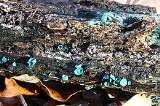
Chlorociboria
Encyclopedia
Chlorociboria is a genus
of fungi within the subphylum Pezizomycetes
. The genus contains 17 species.
There are two known species, Chlorociboria aeruginascens
and Chlorociboria aeruginosa, which can only reliably be distinguished by microscopic examination. C. aeruginosa has larger spores (9–15 µm × 1.5–2.5 µm) and the worm-like cells of the upper surface are rough, unlike the commoner C. aeruginascens, of which the spores are 6–10 µm × 1.5–2 µm.
The hyphae's secondary metabolite
s stain the substrate
oak wood blue-green, with "green oak" being a valued commodity.
Genus
In biology, a genus is a low-level taxonomic rank used in the biological classification of living and fossil organisms, which is an example of definition by genus and differentia...
of fungi within the subphylum Pezizomycetes
Pezizomycetes
Pezizomycetes are a class of fungi within the phylum Ascomycota.Pezizomycetes are apothecial fungi, meaning that their spore producing/releasing bodies are typically disk-like, bearing on their upper surfaces a layer of cylindrical spore producing cells called asci, from which the spores are...
. The genus contains 17 species.
There are two known species, Chlorociboria aeruginascens
Chlorociboria aeruginascens
Chlorociboria aeruginascens is a saprobic species of mushroom, commonly known as the green elfcup or the green wood cup because of its characteristic small, green, saucer-shaped fruit bodies...
and Chlorociboria aeruginosa, which can only reliably be distinguished by microscopic examination. C. aeruginosa has larger spores (9–15 µm × 1.5–2.5 µm) and the worm-like cells of the upper surface are rough, unlike the commoner C. aeruginascens, of which the spores are 6–10 µm × 1.5–2 µm.
The hyphae's secondary metabolite
Secondary metabolite
Secondary metabolites are organic compounds that are not directly involved in the normal growth, development, or reproduction of an organism. Unlike primary metabolites, absence of secondary metabolities does not result in immediate death, but rather in long-term impairment of the organism's...
s stain the substrate
Substrate (biology)
In biology a substrate is the surface a plant or animal lives upon and grows on. A substrate can include biotic or abiotic materials and animals. For example, encrusting algae that lives on a rock can be substrate for another animal that lives on top of the algae. See also substrate .-External...
oak wood blue-green, with "green oak" being a valued commodity.
Habit
- Blue-green stain is evident year-round, with ascocarpAscocarpAn ascocarp, or ascoma , is the fruiting body of an ascomycete fungus. It consists of very tightly interwoven hyphae and may contain millions of asci, each of which typically contains eight ascospores...
germination occurring from summer to fall.
External links
- Chlorociboria at Index FungorumIndex FungorumIndex Fungorum, an international project to index all formal names in the Fungi Kingdom. Somewhat comparable to the IPNI, but with more contributing institutions....

